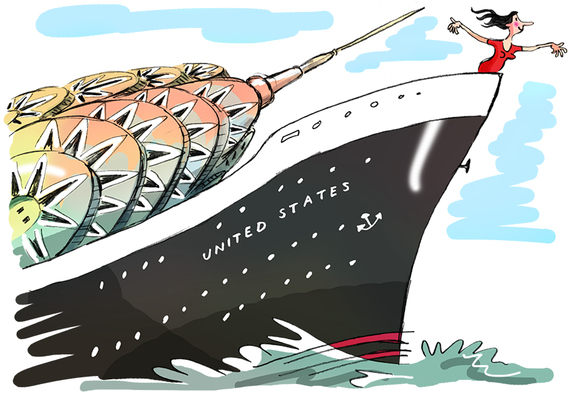I drive into the port of Philadelphia and before me, towering above the other ships in docks lined with freighters, is the elegant prow of the SS United States. This is the unlikely home of what was once the most magnificient steamship in the world and the ultimate symbol of traveling in grand style. The United States made 400 trans-Atlantic crossings, carrying tens of thousands star-struck passengers to Europe and back. But unlike the ill-fated Titanic nobody remembers the United States except those who traveled on it. Yet it was more luxurious, better, bigger than any other ship -- so big that if you put the Chrysler building flat on its deck, you could walk around it.
The ship was launched in 1952 in the middle of the Cold War. It was capable of such great speeds that they were kept top-secret: the ship was slipped the water before it was christened so no enemy spies could take pictures of the design of its sleek hull and propellers. What no one knew was that it could be converted into a warship overnight and used to carry 1,500 troops to an enemy shore faster than any ship ever had. Its top speed was more than 45 knots. On its maiden voyage, the SS United States set the record for the fastest trans-Atlantic crossing that still stands.
But now this grande dame floats unemployed in an undignified harbor, held by huge ropes to a dock. She is exhausted, played out, a wrinkled old lady full of glamorous memories but little else.
My guide is Ray, a friendly man of about thirty who is the ship's devoted caretaker. I am allowed to board only after I sign a stack of releases that in which I take all responsibility for possible exposure to asbestos, PCBs and, for all I know, nuclear waste. It requires the utmost of my empathy to see the grandeur of the past in this stripped-out, rusting hulk. The first-class staterooms are stripped of their walls. The bar is totally dismembered, as is the rust-eaten theater, which was converted on weekends into a synagogue. The ballroom where Grace Kelly once danced is now just a bare steel floor.
What was once the proudest symbol of the achievements of postwar America of the 1950s is rotting here all but forgotten. Ray loves the ship and brings it alive with his rich stories. He monitors its mooring lines and every day climbs to the top of one of its twin smokestacks to eat his lunch, alone with his sandwich and his imagination. The organization that pays him, the SS United States Conservancy (www.ssusc.org) has a primaty goal: that SS United States will be rehabilitated in all its glory. But how? The Conservancy successfully raised money to purchase the ship five years ago to save it from being scrapped. But what now? All that rust will need to be eliminated, the decks rebuilt, the ship freshly painted. And where is the furniture, the auctioned art? Everything has been taken away. The chairs are in restaurants across the country, spoons from the dining room sold on Ebay. Overall, the organization needs perhaps a billion dollars to keep the ship afloat and restored. That is an amount with nine zeros. And in a city like Philadelphia where with historic bridges with names like Whitman and Franklin that also need to be rebuilt.
Ray identifies himself totally with this ship, which for him remains the icing on a cake long since eaten.
"Will it ever happen?" I ask him.
"It will be difficult, but we can make America great again," he says immediately.
I know Donald Trump promises the same thing without rebuilding a ship. But what time and what place does he mean when America was great? The time where a guy like Ray belonged to a proud middle class that worked hard to have a better future? A time when America ruled the oceans? With a ship that was faster than the Queen Mary, more luxurious than the Titanic?
Or it is an idea that itself has outlived its time? Is it, as the poet C.K. Williams writes in his memorable poem about the ship, ready to be torched to pieces on a beach in Bangladesh?
I go to the rusty prow and take a quick selfie of myself as Kate Winslet in the Titanic movie, with my arms raised and my hair and scarf blowing in the wind. When I leave, I turn and look behind me. There I see a huge sign above the captain's bridge. It says: SAVE THE UNITED STATES.ORG.
